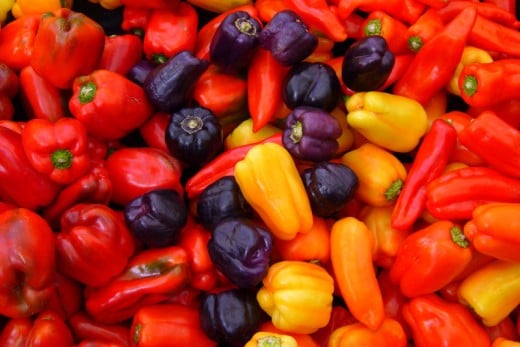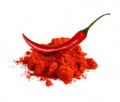What are the Benefits of (Capsicum) Pepper
Where did the Capsicum Pepper Originate
This pepper may well be one of the oldest domesticated plants on the planet with estimates for its use as food going as far back as 8,000 BCE. As with many of the vegetables Americans consider "common" this fruit got it's start in Mesoamerica. It is so old a food, in fact, that no one is certain where in the southern hemisphere of the Americas it was first discovered.
It is currently thought that the Capsicum Annuum was domesticated many times, primarily in what is now Mexico. When Christopher Columbus discovered the Americas (he never actually set food on the continent) one of the seeds he brought back to the old world were those of the red pepper.
Currently over six (6) billion pounds of pepper are grown annually world-wide with India the leader with two (2) billion pounds grown. There are over two hundred (200) varieties of Capsicum annuum.
Capsicum annuum (Latin for annual 'red' pepper) includes scores of cultivars including but not limited to:
- Anaheim (California)
- Ancho (Pablano)
- Bell
- Cayenne
- Fresno
- Italian Sweet
- Jalapeño
- Pepperoncini
- Pimento (also known as cherry pepper)
- Serrano
- Paprika
Oddly the Habañero (also known as the "scotch bonnet") is not of this species.
Capsicum peppers vary in taste and "heat" from no spiciness at all to an intensity that rivals actual fire to skin. Generally speaking the larger the fruit of the pepper the less "heat" it has. This is demonstrated by the Bell and Paprika which have virtually no heat to the cayenne chili which is quite hot.
Lands that grow chilis make a distinction between radiant heat and spiciness. Only in English, it seems, does one word convey two different meanings.
For example in Thai "laun" means thermally hot and "ped" spicy. In Spanish "caliente" is high temperature and "picante" spicy.



Capsicum Pepper as Medicine
Capsicum Annuum has been used for centuries if not millennium as medicine.
Traditional Folk Medicine
As an ancient remedy "hot pepper" has been used:
- As digestive aid
- to treat sore throat and the effect of the common cold
- to raise metabolism
- as a blood purifier
Modern Medicine
Capsicum Annuum contains a phytochemical called capsaicin. This compound has been studied for:
- pain relief
- treatment of diabetes
- a weight loss aid
- treatment for lung congestion
- lowering bad cholesterol
- the treatment of certain cancers
The most success in the study of capsaicin is in the treatment of pain. Capsaicin is believed to work two ways to block pain. First, it is thought that it sends a distracting pain signal confusing and diverting pain signals from the original source of pain. Second, it is thought to "overpower" the pain receptors such that they are effectively "numbed" or "switched off."
This second idea behind capsaicin's pain relieving properties seems to be the valid one. Research has shown that this phytochemical blocks and reduces the amount of substance "P" which is a neurotransmitter associated with both inflammation and the sensation of pain.
Because capsaicin reduces the production of "substance P," it effectively blocks both pain sensation and the associated inflammation.
Scientific American Frontiers
This is a program on PBS hosted by Alan Alda. In one of the broadcasts a sufferer of AIDS experiences high levels of pain in the soles of his feet. As a runner the patient found this particular effect of the HIV infection unbearable. During the episode the patient sat upon a table at the doctor's office. During treatment both his feet were first subjected to a local anesthetic cream. Then a cream of capsaicin was applied to both feet. This "pepper cream" was left on his feet until he reported the pain he felt was almost to the "unbearable" stage.
Bear in mind the patient had already had applied an anesthetic, yet the capsaicin cream was so powerful that he felt pain in his feet.
The capsaicin cream was then promptly wiped off and the patient sent home.
The pain relief of the cream provided this runner with pain-free running for up to six months. That's quite an effect for a substance that is neither a narcotic nor a cortisone cream.
Birds and Peppers
For whatever reason birds do not feel the "heat" of capsicum. For this reason they can eat the smaller peppers with impunity, carrying the seeds in their gut and "depositing" them wherever they go. This is thought to be one of the major factors in the spread of pepper plants on any given continent.
Capsicum Annuum as Nutrient
Because there are so many varieties of pepper it's a bit hard to give a complete nutritional profile; however, consider that any "serving" of 4 oz of pepper will provide the following;
- five (5) grams of carbohydrate
- two and a half (2.5) grams sugar
- almost two (2) grams of fiber
- a third (1/3) gram of fat
- one (1) gram of protein
Pepper also contains vitamin(s) B1, B2, B3, B5, B6, and B9. It also contains vitamin C (more than an equal quantity of citrus at 140% of the RDA), calcium, iron, magnesium, phosphorus, potassium, and zinc.
Less Than Usual Pepper Recipes
Roasting Chilies
Often a necessary step in preparing chilies is roasting them. This sears off the tough outer skin and adds to the flavor profile of the chili. This can be done on a grill, over a gas burner, or in the broiler of an oven.
The idea is to roast the chili just until the skin starts to char. You can do this with a small number of chilies over the open flame of a gas burner. You should always wear gloves when handling chilies and avoid touching your eyes, nose, or mouth during the process. To roast a chili use tongs or a long handled fork to pierce the chili. Hold the chili about 4" (four inches) from the flame and slowly rotate the chili to cook on all sides. The chili is ready to peel when the skin becomes charred.
You can also oven roast your chilies by placing them on a cookie sheet in a 450° F oven. Roast for 4 to 5 minutes or until the skins start to blister.
Any way you've roasted the chilies you want to pop them into a plastic bag to sweat. Let them sit in bag for about ten to fifteen minutes. After that time remove each pepper from the plastic bag, and with rubber gloves, peel each pepper under cold running water. During this time you can also remove the seeds and veins.
Roasted Chili Potato Salad
A great summer-time treat with a bit of a kick.
Ingredients
- 1 Cup mayonnaise (see my mayonnaise recipe here)
- 1 Pound boiled, cubed, red-skinned potatoes
- 1/4 pound roasted, peeled, and seeded jalapeño, serrano, and pablano chilies
Directions
- Add the mayonnaise to a medium mixing bowl
- Add the cubed cooked potato cubes
- Julienne the chilies and fold into the mixture
The dish can be served immediately or chilled overnight.
Chili Pepper Dressing
Ingredients
- 1 large red bell pepper
- 1 fresh green chili such as Anaheim or poblano
- 1 fresh jalapeño chili
- 1 large garlic clove
- 3/4 teaspoon freshly grated lime zest
- 2 Tablespoons finely chopped fresh coriander
- 1 Tablespoon finely chopped fresh oregano leaves
- 2 Tablespoons fresh lemon juice
- 2 Tablespoons fresh lime juice
- 1/2 Cup olive oil
Directions
-
Roast and peel bell pepper and Anaheim or poblano chili
- Finely chop roasted pepper and chili
- Wearing rubber gloves, seed and mince jalapeño chili. Mince garlic
- In a bowl whisk together all ingredients with salt and
pepper to taste
Makes about 1 1/4 cups.











